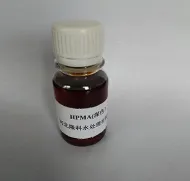Hydrolyzed Polymaleic Anhydride: Green Pioneer in Scale Inhibition Field
In the scale inhibition battlefield of industrial production and water treatment, Anhidrida Polimaleik Terhidrolisis has become a highly regarded green scale inhibitor with its unique performance and environmental advantages. It is like a vanguard guardian of stable equipment operation, opening up new paths to solve the problem of scale.

The efficient scale inhibition ability of Hydrolyzed Polymaleic Anhydride is attributed to its sophisticated molecular structure and mechanism of action
The large number of carboxyl groups on the HPMA molecular chain have strong chelating ability, which can react with metal ions such as calcium and magnesium in water to form stable water-soluble complexes, firmly "locking" the easily scaling ions and preventing them from forming scale precipitates. At the same time, Hydrolyzed Polymaleic Anhydride also has dispersibility and can adsorb on the surface of tiny scale crystal nuclei. With electrostatic repulsion and steric hindrance effects, it effectively hinders the growth and aggregation of crystal nuclei, allowing scale particles to be evenly dispersed in water, thereby avoiding sedimentation on the equipment surface and ensuring smooth system operation.
From the perspective of actual performance, Hydrolyzed Polymaleic Anhydride has demonstrated outstanding scale inhibition capabilities
Under different water quality conditions, whether facing complex water with high hardness and alkalinity, or harsh working conditions with high temperature and high pH value, it can exhibit good inhibitory effects on common scale such as calcium carbonate and calcium sulfate at lower dosing concentrations. Moreover, s has excellent chemical stability and thermal stability. It can maintain its activity for a long time in the circulating water system, continuously exerting its anti scaling effect, effectively reducing the risk of equipment failure caused by scaling, and improving equipment operating efficiency.
With outstanding scale inhibition performance and environmental characteristics, Hydrolyzed Polymaleic Anhydride has demonstrated its prowess in numerous fields
In industrial circulating cooling water systems, it can significantly reduce scale deposition on the surfaces of pipelines and heat exchange equipment, reduce energy consumption, and extend equipment service life; In boiler water treatment, it can prevent furnace tube scaling, improve heat conduction efficiency, and ensure safe and stable operation of the boiler; In the oilfield water injection system, it helps prevent formation blockage, maintain smooth water injection channels, and improve crude oil recovery. In addition, in scenarios such as residential hot water systems and air conditioning circulating water systems, Anhidrida Polimaleik Terhidrolisis also plays an important role in scale inhibition.
With the deepening of environmental protection concepts and continuous innovation of industrial technology, the research and development of Hydrolyzed Polymaleic Anhydride is also constantly advancing
Researchers focus on further optimizing its synthesis process, improving product performance, and enhancing its biodegradability research to develop more environmentally friendly products. In the future, HPMA is expected to achieve breakthroughs in more fields, providing higher quality scale inhibition solutions for industrial production and daily life with more efficient and environmentally friendly characteristics.
In summary, Hydrolyzed Polymaleic Anhydride holds an important position in the field of scale inhibition due to its unique scale inhibition mechanism, outstanding performance, and environmental advantages. It not only effectively solves the problem of scale and ensures the stable operation of equipment, but also meets the needs of the era of green development. With the continuous advancement of technology, Hydrolyzed Polymaleic Anhydride will continue to shine and generate heat in the field of scale inhibition in the future, contributing greater strength to the sustainable development of industry and people's high-quality life.
Hydrolyzed Polymaleic Anhydride FAQs
What is Hydrolyzed Polymaleic Anhydride?
Hydrolyzed Polymaleic Anhydride is a water-soluble polymer obtained by hydrolysis of poly (maleic anhydride), which has excellent scale inhibition and dispersion properties. It is commonly used in industrial water treatment fields, such as cooling water systems, boiler water treatment, etc.
What is the main function of Hydrolyzed Polymaleic Anhydride?
It mainly prevents inorganic salts such as calcium carbonate and calcium sulfate from scaling in water systems by chelating metal ions, dispersing suspended particles, and inhibiting scale formation. At the same time, it can effectively stabilize metal ions such as iron and zinc.
What are the advantages of Hydrolyzed Polymaleic Anhydride compared to traditional scale inhibitors such as polyacrylic acid?
Hydrolyzed Polymaleic Anhydride has stronger stability and higher scale inhibition efficiency in high temperature and high pH environments, and its biodegradability is better than some synthetic polymers, making it more environmentally friendly.
What industries is Hydrolyzed Polymaleic Anhydride suitable for?
Mainly used in circulating cooling water systems, reverse osmosis membrane scale inhibition, and oilfield reinjection water treatment in industries such as power, petrochemicals, steel, and textiles. It can also be used as a detergent additive or ceramic dispersant.
What should be noted when using Hydrolyzed Polymaleic Anhydride?
The dosage should be determined based on water quality (such as hardness, pH) and system operating conditions, as excessive dosage may affect the effectiveness;
Avoid direct mixing with cationic agents as precipitation may occur;
When storing, it should be moisture-proof as it is prone to moisture absorption.
-
Pbtc Scale InhibitorPBTC: A Scale Protector for Industrial Water TreatmentBeritaAug.05,2025
-
Organic Phosphonate: An Efficient Defender in the Field of Scale InhibitionBeritaAug.05,2025
-
Hydrolyzed Polymaleic Anhydride: Green Pioneer in Scale Inhibition FieldBeritaAug.05,2025
-
PAPEMP Polyamino Polyether Methylene Phosphonic Acid For SaleBeritaAug.05,2025
-
Flocculant Water Treatment: A Pioneer in Purification in the Field of Water TreatmentBeritaAug.05,2025
-
Benzyl Isothiazolinone: An Efficient and Broad-Spectrum Antibacterial Protective GuardBeritaAug.05,2025





